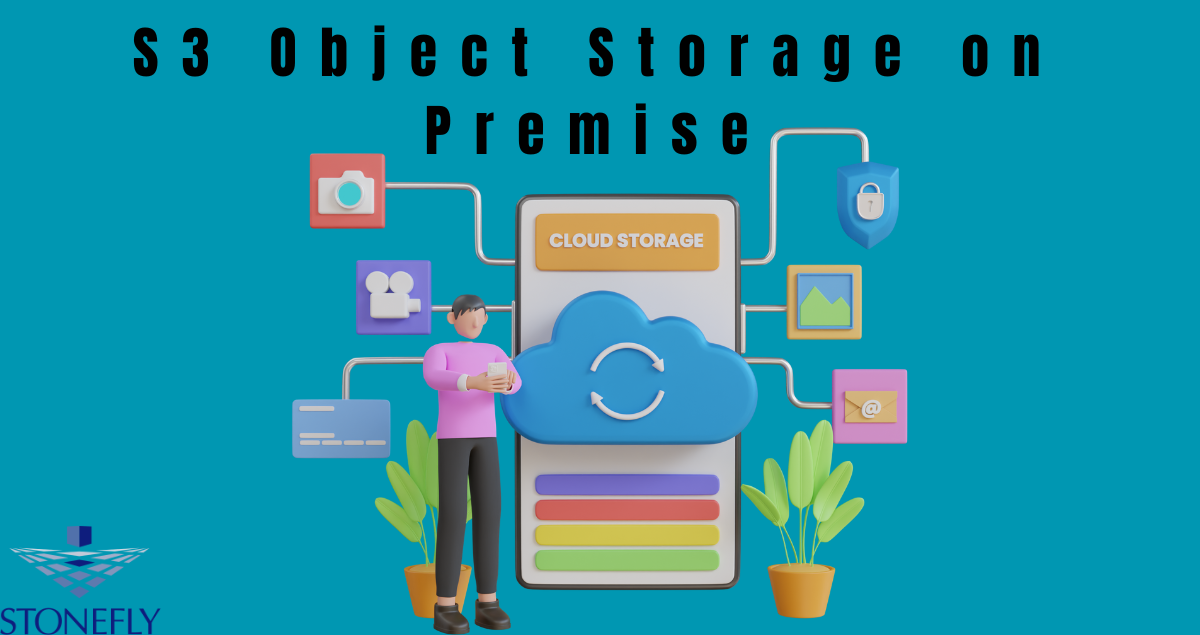S3 Object Storage on Premise: Revolutionizing Data Management
In today’s data-driven world, businesses are constantly looking for innovative storage solutions to manage their growing volumes of data. Enter S3 object storage on premise – a powerful, scalable, and cost-effective solution that promises to revolutionize the way organizations handle their data. This blog post will explore the concept of S3 Object Storage on Premise , its architecture, benefits, use cases, implementation guidelines, best practices, and future trends, all while answering some frequently asked questions.
Introduction to S3 Object Storage on Premise
S3 object storage on premise is an advanced storage solution that brings the benefits of cloud-based object storage to your local infrastructure. By using the same protocols and APIs as popular cloud storage services, businesses can achieve high scalability, durability, and accessibility without relying on external cloud providers. This approach ensures that sensitive data remains within the company’s control, providing enhanced security and compliance.
S3 object storage on premise is particularly beneficial for organizations with strict data sovereignty requirements or those operating in industries with strict regulatory compliance needs. By keeping data in-house, companies can align with industry-specific regulations and maintain complete control over their storage environment. Additionally, this solution offers significant cost savings by eliminating the need for recurring cloud storage fees.
In this blog post, we will take a closer look at the architecture, advantages, implementation process, best practices, and future trends of S3 object storage on premise. By the end, you’ll have a comprehensive understanding of how this innovative storage solution can benefit your business.
Understanding the Architecture
The architecture of S3 object storage on premise is designed to provide seamless integration with existing IT infrastructure while maintaining the core principles of object storage. At its core, the system consists of a distributed storage cluster that stores data as objects, each identified by a unique key. These objects are stored in a flat namespace, allowing for easy scalability and management.
One of the key components of S3 object storage on premise is the storage nodes. These nodes are responsible for storing and managing the data objects. Each node in the cluster communicates with others to ensure data redundancy and high availability. This distributed nature of the storage cluster ensures that even if one node fails, the data remains accessible from other nodes, providing robust fault tolerance.
Another crucial aspect of the architecture is the S3-compatible API. This API allows applications and users to interact with the storage system using familiar commands and protocols. By adhering to the S3 standard, businesses can easily integrate on premise storage with existing applications, tools, and workflows without significant modifications. This compatibility simplifies the transition to S3 object storage on premise and reduces the learning curve for IT teams.
Comparison with Traditional Storage Systems
When comparing S3 object storage on premise with traditional storage systems, several key advantages become apparent. First and foremost is scalability. Unlike traditional storage systems that rely on hierarchical file structures, object storage uses a flat namespace. This design allows for virtually unlimited scalability, making it easier to manage and store large volumes of data without the constraints of directory hierarchies.
Cost is another significant factor. Traditional storage systems often require substantial upfront investments in hardware and ongoing maintenance costs. In contrast, S3 Object Storage on Premise offers a more cost-effective solution. By using commodity hardware and leveraging the distributed nature of object storage, businesses can achieve high storage capacity at a lower cost. Additionally, the pay-as-you-grow model eliminates the need for over-provisioning, further reducing expenses.
Flexibility is also a major advantage. Object storage allows for the storage of unstructured data, such as multimedia files, backups, and logs, in a more efficient manner. This flexibility is particularly valuable for organizations dealing with diverse data types and large datasets. Traditional storage systems may struggle to handle such data efficiently, leading to performance bottlenecks and increased complexity.
Use Cases and Industry Applications
S3 object storage on premise is being utilized across various industries, demonstrating its versatility and effectiveness. In the healthcare sector, organizations are leveraging this storage solution to manage and store vast amounts of medical imaging data, electronic health records (EHRs), and research data. The ability to securely store sensitive patient information on premise ensures compliance with privacy regulations while providing quick access to critical data.
In the media and entertainment industry, companies are using S3 object storage on premise to store and manage large volumes of multimedia content, such as videos, images, and audio files. The scalability and performance of object storage enable seamless streaming and distribution of content to global audiences. Additionally, the metadata capabilities of object storage allow for efficient content indexing and retrieval, enhancing workflow efficiency.
The finance sector is benefiting from S3 object storage on premise by securely storing transaction records, audit logs, and compliance documents. The distributed nature of object storage ensures data integrity and availability, even in the event of hardware failures. Financial institutions can also leverage the scalability of object storage to accommodate growing data volumes and meet regulatory requirements.
Implementing S3 object storage on premise
Integrating and deploying S3 object storage on premise within your infrastructure requires careful planning and execution. Begin by assessing your current storage needs and identifying the data types and volumes you need to store. This assessment will help you determine the appropriate hardware requirements and storage capacity for your on premise solution.
Next, select a reliable S3 object storage on premise platform that aligns with your business requirements. Consider factors such as scalability, ease of integration, compatibility with existing applications, and vendor support. Once you have chosen a platform, follow the installation and configuration guidelines provided by the vendor to set up the storage cluster and ensure proper connectivity.
During the implementation process, it is essential to establish a robust data migration strategy. This strategy should include steps for transferring existing data from legacy storage systems to the new object storage environment. Ensure that data integrity is maintained during the migration process and perform thorough testing to verify the successful transfer of data.
Considerations and Best Practices
When implementing and managing S3 object storage on premise systems, there are several key considerations and best practices to keep in mind. First and foremost, prioritize data security. Implement encryption mechanisms to protect data at rest and in transit. Regularly update and patch the storage platform to address any security vulnerabilities and ensure compliance with industry standards.
Monitoring and performance optimization are also critical. Implement monitoring tools to track the health and performance of the storage cluster. Monitor key metrics such as storage capacity, response times, and error rates to identify and address any potential issues proactively. Regularly optimize the storage system by performing maintenance tasks such as data deduplication, compression, and load balancing.
Data lifecycle management is another important aspect. Define policies for data retention, archiving, and deletion to ensure efficient storage utilization. Implement automated workflows to handle data lifecycle operations, reducing manual intervention and minimizing the risk of data loss. Regularly review and update these policies to align with changing business requirements and regulatory guidelines.
Future Trends
The future of S3 object storage on premise holds exciting possibilities as technology continues to evolve. One emerging trend is the integration of artificial intelligence (AI) and machine learning (ML) capabilities into storage platforms. AI and ML can enhance data management by automating tasks such as data classification, content indexing, and anomaly detection. This integration will further streamline storage operations and improve overall efficiency.
Another trend is the convergence of on premise and cloud storage. Hybrid storage solutions that combine the benefits of S3 object storage on premise with the scalability and flexibility of cloud storage are gaining traction. This approach allows businesses to leverage the strengths of both environments, optimizing storage costs and performance based on their specific needs.
Edge computing is also expected to play a significant role in the future of S3 object storage on premise. With the proliferation of Internet of Things (Iota) devices and the need for real-time data processing, edge computing enables data to be processed closer to the source. By integrating S3 object Storage on premise with edge computing infrastructure, businesses can achieve low-latency data access and improved performance for time-sensitive applications.
Conclusion
S3 object storage on premise offers businesses a powerful and flexible solution for managing their data. With its scalability, cost-effectiveness, and compatibility with existing systems, it provides a compelling alternative to traditional storage methods. By understanding the architecture, benefits, use cases, implementation guidelines, best practices, and future trends discussed in this blog post, you can make informed decisions about integrating S3 object storage on premise into your organization’s infrastructure.
If you’re ready to explore the potential of S3 object storage on premise for your business, start by assessing your storage needs and selecting a reliable platform. Implement best practices for security, monitoring, and data lifecycle management to maximize the benefits of your storage solution. Stay informed about emerging trends and advancements in the field to stay ahead of the curve.
FAQs
1. What is the main advantage of S3 object storage on premise over traditional storage systems?
The main advantage is scalability. S3 object storage on premise uses a flat namespace, allowing for virtually unlimited scalability without the constraints of hierarchical file structures.
2. How can S3 object storage on premise benefit the healthcare industry?
It enables secure storage of vast amounts of medical imaging data, electronic health records (EHRs), and research data, ensuring compliance with privacy regulations while providing quick access to critical information.
3. What are some key considerations when implementing S3 object storage on premise?
Prioritize data security, implement monitoring and performance optimization tools, and define policies for data lifecycle management to ensure efficient storage utilization.
4. How can AI and machine learning enhance S3 object storage on premise?
AI and ML can automate tasks such as data classification, content indexing, and anomaly detection, improving overall efficiency and streamlining storage operations.
5. What is the future of S3 object storage on premise?
The future includes the integration of AI and ML capabilities, convergence with cloud storage, and the adoption of edge computing to achieve low-latency data access and improved performance for time-sensitive applications.




